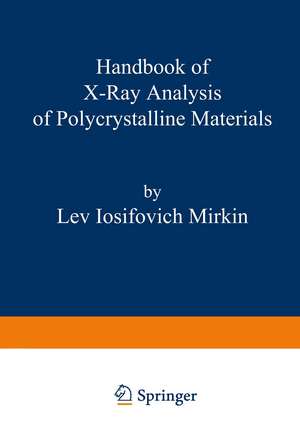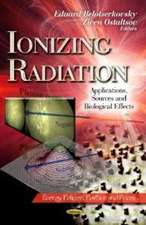Handbook of X-Ray Analysis of Polycrystalline Materials
Autor Lev. I. Mirkinen Limba Engleză Paperback – 17 mar 2012
Preț: 425.09 lei
Nou
Puncte Express: 638
Preț estimativ în valută:
81.37€ • 88.41$ • 68.39£
81.37€ • 88.41$ • 68.39£
Carte tipărită la comandă
Livrare economică 21 aprilie-05 mai
Preluare comenzi: 021 569.72.76
Specificații
ISBN-13: 9781468460629
ISBN-10: 1468460625
Pagini: 756
Ilustrații: XX, 732 p.
Dimensiuni: 178 x 254 x 40 mm
Greutate: 1.29 kg
Ediția:Softcover reprint of the original 1st ed. 1964
Editura: Springer Us
Colecția Springer
Locul publicării:New York, NY, United States
ISBN-10: 1468460625
Pagini: 756
Ilustrații: XX, 732 p.
Dimensiuni: 178 x 254 x 40 mm
Greutate: 1.29 kg
Ediția:Softcover reprint of the original 1st ed. 1964
Editura: Springer Us
Colecția Springer
Locul publicării:New York, NY, United States
Public țintă
ResearchDescriere
The book is best used in the following sequence. (1) The radiation and method of recording are selected in accordance with the data of Chapters 1 and 2; the detailed param eters for the recording are defined. (2) The patterns are indexed with the assistance of the graphs and tables of Chapter 3. (3) The measured intensities are compared with the values found from the tables of Chapter 4. (4) The particular problem at hand (determi nation of stresses, phase analysis, and so on) is solved with the aid of the tables and nomo grams given in the second part of the book. The nomograms can be enlarged for use if necessary. This is not the only mode of use; in particular, the material in the appropriate chapter may be sufficient for a particular type of routine analysis. I have had the benefit of valuable advice from workers in various laboratories (Moscow State University, Moscow Steel Institute, the Institute of Crystallography, the Central Research Institute for Ferrous Metallurgy, the Technological Research Institute of the Automobile Industry, the Karpov Institute of Physical Chemistry, the All-Union Hard Alloys K~search Institute, and so on). In addition, I am deeply indebted for much assistance to Professor Ya. S. Umanskii (scientific editor), Professor V. I. Iveronova, Professor A. I. Kitaigorodskii, G. A. Gol'der, and V. I. Rydnik. I recognize that this work cannot be free from deficiencies, and I should like to thank in advance workers in x-ray laboratories who may offer criticisms.
Cuprins
1: General Methods of X-Ray Structure Analysis.- 1. Interaction of X-Rays with Matter. X-Ray Spectra.- 1-1. Characteristic X-Rays.- 1-1a. Wavelengths of the K-Series X-Rays.- 1-1b. Wavelengths of the L-Series X-Rays.- 1-1c. Relative Intensities of the K Lines in the Characteristic Spectrum.- 1-1d. Widths of the Lines of the Characteristic Spectrum.- 1-1e. Asymmetry Indices for Lines of the Characteristic Spectrum.- 1-2. Conversion of kX Units to Angstroms.- 1-3. Relations between Units for Absorption Coefficients.- 1-4. Scattering of X-Rays.- 1-4a. Scattering of X-Rays by Electron Shells and Nuclei.- 1-4b. Scattering of X-Rays in Gases.- 1-4c. Scattering Coefficients for X-Rays.- 1-4d. Mass Scattering Coefficients ?s/?.- 1-4e. Scattering Coefficients ?e.- 1-4f. Incoherent Scattering Cross Sections for X-Rays.- 1-5. Absorption of X-Rays.- 1-5a. Absorption Edges for Some Elements.- 1-5b. Calculation of Absorption Coefficients.- 1-5c. Nomogram for Determining Absorption Coefficients.- 1-6. Total Attenuation of X-Rays.- 1-6a. Atomic Attenuation Coefficients.- 1-6b. Mass Attenuation Coefficients ?/? for Long Wavelengths.- 1-6c. Mass Attenuation Coefficients ?/? for Short Wavelengths.- 1-6d. Mass Attenuation Coefficients ?/? for Elements.- 1-6e. Mass Attenuation Coefficients ?/? for Some Compounds.- 1-6f. Half-Value Layers for Some Elements.- 1-6g. Half-Value Layers as Functions of Angle of Incidence.- 1-7. Ionizing Effects of X-Rays.- 1-8. Refraction of X-Rays.- 1-8a. Unit Decrements of Refractive Index.- 1-8b. Angle of Total Internal Reflection.- 2. Production and Measurement of X-Ray Patterns.- 2-1. Equipment for X-Ray Laboratories.- 1. X-Ray Equipment.- 2. X-Ray Tubes and Rectifiers.- 3. X-Ray Cameras.- 4. Microphotometers.- 2-2. Production of Focused Lines.- 2-3. Methods of Examining Transformations and Lattice States at High and Low Temperatures.- 2-4. Photographic Recording.- 2-4a. Recording of Patterns from Certain Materials.- 2-4b. Nomogram for Setting up Back-Reflection Cameras.- 2-4c. Nomogram for Setting Cameras for Express Recording.- 2-5. Ionization Recording.- 2-5a. Radiation Detectors.- 2-5b. Absorption of X-Rays in Geiger Counters.- 2-5c. Efficiencies of Counters.- 2-6. Selective Filters.- 2-7. Characteristics of Monochromator Crystals.- 2-7a. Reflections and Properties of Monochromator Crystals.- 2-7b. Reflectivity of Monochromator Crystals.- 2-7c. Optimal Thickness of Monochromator Crystal for Use in Transmission.- 2-7d. Properties of Plane Monochromator Crystals.- 2-7e. Reflection Angles for Bent Monochromator Crystals.- 2-8. Parameters for Use with Bent Quartz Crystals.- 2-9. Measurement of Diffraction Lines on Patterns.- 2-9a. Determination of Bragg Angles for a Flat Film.- 2-9b. Correction for Deviation of Camera Diameter from Standard.- 2-9c. Correction for Specimen Thickness.- 2-9d. Correction for Eccentricity of Specimen in Camera.- 2-10. Intensity Measurements.- 2-10a. Number of Counts Needed to Give a Specified Probable Error.- 2-10b. Statistical Error of Count.- 2-10c. Correction for Particle Size, Fixed Specimen.- 2-10d. Correction for Particle Size, Rotating Specimen.- 2-10e. Correction for Lost Counts.- 2-11. Doublet Splittings.- 2-12. Data for Calculations on Laue Patterns.- 2-12a. Net for Calculations on Back-Reflection Patterns.- 2-12b. Net for Calculations on Transmission Patterns.- 2-12c. Accessory Table for Constructing the Projection of the Crystal from the Laue Pattern.- 2-13. Determination of Orientation for Large Crystals in Polycrystalline Materials.- 3. Indexing of X-Ray Patterns.- 3-1. Accessory Tables.- 3-1a. Some Composite Trigonometric Functions.- 3-1b. Values of 1/d2.- 3-1c. Values of n? and lg (n?/2).- 3-1d. Values of ?, ?/2, ?2/4, lg (?2/4), and (?/2)?n.- 3-2. Space-Group Symbols.- 3-3. Tables of Absences for Determining X-Ray Groups.- Cubic System.- 3-4. Schemes for X-Ray Patterns.- 3-5. Quadratic Forms.- 3-6. Graphs for Indexing X-Ray Patterns.- 3-7. Graphs for Determining Whether a Material is Cubic.- 3-8. Limiting Values for Sums of the Squares of Indices for Various Unit-Cell Volumes and Radiations.- Tetragonal System.- 3-9. Schemes for X-Ray Patterns.- 3-10. Quadratic Forms.- 3-11. Values of (a/c)2l2.- 3-12. Analytic Method of Indexing X-Ray Patterns.- 3-13. Graphs for Indexing X-Ray Patterns.- Hexagonal System.- 3-14. Schemes for X-Ray Patterns.- 3-15. Quadratic Forms.- 3-16. Analytic Method of Indexing for the Hexagonal and Trigonal Systems.- 3-17. Graphs for Indexing X-Ray Patterns.- 3-18. Relations between Indices in Indexing for the Hexagonal, Trigonal, and Orthohexagonal Systems.- Trigonal System.- 3-19. Quadratic Forms.- 3-20. Values of (2 cos ?)/(1 + cos ?) = 1 — tg2 (?/2).- 3-21. Relation of ? to c/a for the Trigonal System.- 3-22. Relation of Sum of the Squares of the Indices to ? for Fixed Cell Volume.- 3-23. Graphs for Indexing X-Ray Patterns.- Orthorhombic System.- 3-24. Analytic Method of Indexing X-Ray Patterns.- 3-25. Graphs for Indexing X-Ray Patterns.- Lower Systems.- 3-26. Graphical Method of Indexing X-Ray Patterns.- 3-27. Use of the Theory of Homology in Indexing Patterns for Crystals of Low Symmetry.- 4. Line Intensities on X-Ray Patterns.- 4-1. Some Formulas for Line Intensities.- 4-2. Values of e4?3/2m2c4.- Angular Intensity Factors.- 4-3. Product of the Polarization, Lorentz, and Geometric Factors for Patterns Recorded without Monochromators.- 4-3a. Debye Patterns in Cylindrical Cameras.- 4-3b. Recording on Flat Film.- 4-3c. Reflection from a Monocrystal.- 4-4. Product of the Polarization, Lorentz, and Geometric Factors for Symmetrical Recording with a Monochromator.- 4-5. Some Trigonometric Functions.- Atomic Intensity Factors.- 4-6. Accessory Table for Calculating Atomic Factors.- 4-7. Atomic Scattering Factors for Atoms and Ions.- 4-8. Correction for Anomalous Dispersion.- 4-8a. Values of ?fk?.- 4-8b. Values of ?fk?.- 4-8c. Values of ?K for Some Elements.- Structure Factors.- 4-9. Accessory Table for Calculating Structure Factors,.- 4-10. Nomogram for Calculating Structure Factors.- 4-11. Array of Atoms in Some Types of Crystal Structure.- 4-12. Structure Factors for Some Cubic Space Groups.- 4-13. Structure Factors for Some Cubic Structure Types.- 4-14. Structure Factors for Some Tetragonal Space Groups.- 4-15. Structure Factors for Some Hexagonal Space Groups.- 4-16. Structure Factors for Some Hexagonal Structure Types.- 4-17. The Temperature Factor.- 4-17a. Debye’s function.- 4-17b. Values of the Temperature Factor for Various B and ?.- 4-17c. The Functions e?x and lg e?x.- 4-17d. Values of B? in the Expression for the Temperature Factor.- 4-18. Multiplicity Factors for the Various Crystal Systems.- Absorption Factors.- 4-19. Absorption Factors for Cylindrical Specimens.- 4-19a. Absolute Values for Homogeneous Specimens.- 4-19b. Relative Values for Homogeneous Specimens.- 4-19c. Absolute Values for Powder Specimens Attached to Fibers.- 4-20. Absorption Factors for Plane Specimens.- 4-21. Absorption Factors for Spherical Specimens.- 4-21a. Absolute Values.- 4-21b. Relative Values.- 4-22. Absorption Factors for Powder Mixed with Binder.- 2: Some Special Problems and Methods in X-Ray Structure Analysis.- 5. Phase Analysis.- 5-1. Methods.- 5-1a. Qualitative Methods.- 5-1b. Quantitative Methods Involving Intensity Measurement.- 5-2. Crystal Structures of Elements and Compounds.- 5-3. Interplanar Distances and Line Intensities for Elements and Compounds.- 5-4. Tables for Phase Analysis of Isomorphous Compounds.- 5-4a. Cubic System.- 5-4b. Tetragonal System.- 5-4c. Hexagonal System.- 5-5. Method of Homologous Pairs.- 5-5a. Homologous Pairs for Determining Austenite in Steels.- 5-5b. Homologous Pairs for Quantitative Analysis of Two-Phase Brasses.- 5-5c. Homologous Pairs for Analysis of Oxides on Steel.- 5-6. Method of Superposition.- 5-7. Conversion of Weight Percent to Atomic Percent.- 6. Precision Measurement of Lattice Constants.- 6-1. Aspects of Precision Methods of Measuring Lattice Constants.- 6-1a. Asymmetric Recording.- 6-1b. Recording at Large Distances in Divergent Beams.- 6-1c. Use of a Standard.- 6-1d. Graphical Extrapolation.- 6-1e. Combined Graphical Extrapolation and Calculation.- 6-1f. Analytic Least-Squares Method.- 6-1g. Method Not Involving Use of a Standard.- 6-1h. Aspects of Precision Determination by Ionization Methods.- 6-2. Choice of Method in Precision Determinations.- 6-2a. Methods of Measurement.- 6-2b. Choice of Method.- 6-3. Choice of Radiation for Cubic Crystals.- 6-4. Choice of Radiation for Tetragonal Crystals.- 6-5. Choice of Radiation for Hexagonal and Trigonal Crystals.- 6-6. Choice of Conditions for Certain Materials.- 6-7. Tables for Determining Lattice Constants of Cubic Substances.- 6-7a. Use of Copper Radiation.- 6-7b. Use of Nickel Radiation.- 6-7c. Use of Cobalt Radiation.- 6-7d. Use of Iron Radiation.- 6-7e. Use of Chromium Radiation.- 6-8. Extrapolation Functions.- 6-8a. Function cos2?.- 6-8b. Function ½(cos2?)/sin ? + (cos2?)/?].- 6-8c. Function ? tg ?.- 6-9. Lattice Constants of Some Standard Substances.- 6-10. Bragg Angles for Some Standard Substances.- 6-10a. NaCl.- 6-10b. Ag.- 6-10c. Au.- 6-10d. Polycrystalline Quartz.- 6-10e. Monocrystalline Quartz.- 6-10f. Some Lines of Al, Cr, Au, Ag, and W.- 6-11. Factors for Reducing sin2? to a Single Wavelength.- 6-12. Correction for Refraction.- 6-13. Linear-Expansion Coefficients for Some Metals, Alloys, and Other Materials.- 7. Determination of Macroscopic Stresses.- 7-1. Some Formulas for Stress Determination.- 7-2. Accessory Table for Determining Stresses in Iron, Copper, Aluminum, and Alloys of These.- 7-3. Stresses Producing a Line Shift of 0.1 mm for Various Materials and Conditions.- 7-4. Accessory Function for Calculating Macroscopic Stresses in Iron from Patterns Taken with Cobalt Radiation.- 7-5. Values of Constants in Stress-Determination Relations.- 7-6. Correction for Relation between ?x and ?y.- 7-7. Correction for Film Movement.- 7-8. Nomogram for Determining Stresses.- 8. Determination of Crystallite and Block Sizes, of Microstresses, and of Lattice Distortion.- 8-1. Determination of Crystallite Sizes.- 8-1a. From Size and Number of Spots on Pattern.- 8-1b. Table for Determining Block Sizes from Line Intensities.- 8-2. Measurement of Crystallite and Block Sizes from Line Intensities.- 8-3. X-Ray Determination of Dislocation Densities.- 8-4. Geometric Broadening of Lines on X-Ray Patterns.- 8-5. Correction for Heterochromatic Radiation.- 8-6. Physical Line Broadening.- 8-7. Separation of the Effects of Block Size and of Microstresses.- 8-8. Microstress Anisotropy Factor.- 8-9. Block-Shape Constant.- 8-10. Determination of True Width and Shape of Lines from Fourier Series.- 8-10a. A cos 2?tx.- 8-10b. A sin 2?tx.- 8-10c. Tables for Determining Positions of Peaks.- 8-11. Determination of Dynamic Lattice Distortions and Characteristic Temperatures.- 8-12. Determination of Static Lattice Distortions of Atomic Scale.- 9. Determination of Preferred Orientations (Textures).- 9-1. The Wulff Net.- 9-2. The Polar Net.- 9-3. Standard Projections of Crystals.- 9-4. Angles between Atomic Planes.- 9-4a. Cubic System.- 9-4b. Tetragonal System.- 9-4c. Hexagonal System.- 9-5. Nets for Constructing Polar Figures for a Flat Film.- 9-6. Net for Constructing Polar Figures When an Axial Camera is Used.- 9-7. Correction for Absorption in Ionization Recording.- 10. Diffuse Scattering of X-Rays and Small-Angle Scattering.- 10-1. Some Formulas for the Diffuse-Scattering Intensity.- 10-2. Values of s(?) for Various Radiations.- 10-3. Polarization Factor for Diffuse Scattering.- 10-4. Angular Intensity Factors.- 10-5. Incoherent-Scattering Intensity.- 10-6. Relativistic Correction for Incoherent Scattering.- 10-7. Values of q for Particles of Various Shapes.- 10-8. Scattering Functions for Systems of Homogeneous Particles.- 10-8a. Spherical Particles (General Values).- 10-8b. Spherical Particles (Maxima and Minima).- 10-8c. Ellipsoid of Rotation.- 10-8d. Particles in the Form of Cylinders.- 10-8e. Particles in the Form of Cylinders of Small Diameter.- 10-8f. Particles in the Form of Elliptic Cylinders.- 10-8g. Particles in the Form of Discs.- 10-8h. Particles in the Form of Rectangular Prisms.- 10-9. Graph for Determining Radii of Gyration of Particles.- 10-10. Scattering by Inhomogeneous Systems of Particles.- 10-10a. System of Spherical Particles.- 10-10b. Scattering Function for a System of Spherical Particles Separated by Gaps.- 10-10c. Scattering Function for a System of Spherical Particles of Various Radii.- 10-10d. System of Particles with a Linear Structure.- 10-10e. Short-Range Order in Particle Disposition.- 10-11. Scattering Curves for Various Particle-Size Distributions.- 10-12. The Collimator Effect.- 10-12a. Effect of the Collimator on the Scattering Function.- 10-12b. Effect of the Collimator on the Turning Points in the Scattering Function.- 10-12c. Choice of Collimator.- 11. Electron Diffraction.- 11-1. Some Formulas for Electron Diffraction.- 11-2. Relation of Electron Wavelength to Applied Voltage.- 11-3. ? Correction in Precision Interplanar Distance Measurements.- 11-4. Universal Atomic-Scattering Function for Electrons.- 11-5. Atomic Scattering Factors for Electrons.- 11-5a. Scattering by Light Atoms.- 11-5b. Scattering by Atoms of Medium and High Atomic Numbers.- 11-5c. Scattering by Ions.- 11-6. Symmetry of Point Patterns.- 12. Neutron Diffraction.- 12-1. Some Formulas for Neutron Diffraction.- 12-2. Characteristics of Neutrons of Various Energies.- 12-3. Properties of X-Rays and Neutrons.- 12-4. Neutron Scattering by Isotopes.- 12-5. Neutron Absorption.- 12-6. Nuclear and Magnetic Scattering Amplitudes for Neutrons.- 12-7. Form Factors for Magnetic Scattering for Atoms and Ions.- 12-8. Effective Neutron-Scattering Cross Sections for Metals and Alloys.- Literature Cited.








